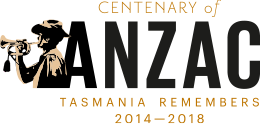Stanley Memorial
Paving the way to remember them
The Stanley community has shown long term dedication to preserving the memory of local men who served in World War One.
In 1927, the Stanley community, in Tasmania’s north-west, raised £242 for their Soldiers Memorial made of Italian Carrara marble.
Now, the Circular Head RSL Sub Branch, which formed an ANZAC Centenary Committee, has successfully applied for a Centenary of ANZAC grant of $5,000 for Stanley World War One Commemorative Pavers.
Stanley’s ANZAC Centenary Committee has brought together a range of community members to coordinate the Centenary of ANZAC projects, including students from Smithton High School and Circular Head Christian School, who have researched the 66 soldiers on the Stanley Soldiers Memorial and 20 other fallen soldiers with links to the Circular Head area.
The Stanley World War One Commemorative Pavers feature the personal details of 86 fallen soldiers from the local area. The Rising Sun emblem is a pivotal part of the design and covers 12 pavers.
The Godfreys Beach precinct was chosen for the commemorative pavers as the waterfront setting, the cliffs of the Nut, and sound of lapping waves upon the shore were perceived as evocative when reflecting on the beach landings by Australian and New Zealand troops at Gallipoli on 25 April 1915.
Memorials are necessary reminders
When the Soldiers Memorial at Alexander Terrace, Stanley, was unveiled on the 24th May 1927 by Mr Lieutenant John Marriott MHA, he stated:
“Memory was short … memorials … were necessary as reminders. The graves of the men who fell were scattered over the Empire’s battlefields. This monument represented their tomb.”
At the time, Mr Marriott said he hoped that the residents would never pass the Stanley Soldiers Memorial without lifting their hats or bowing their heads.
The Stanley community of 2015 has not disappointed Mr Marriott. The community continues to pay tribute to the soldiers through the new pavers, photographic displays and the students’ research, which has been used for presentations and an exhibition. and There are also plans for a book to be developed.
When next in the Circular Head area, consider visiting the new commemorative pavers, Stanley Discovery Museum, and Smithton Heritage Centre.
Find out about other successful Centenary of ANZAC grant recipients.



